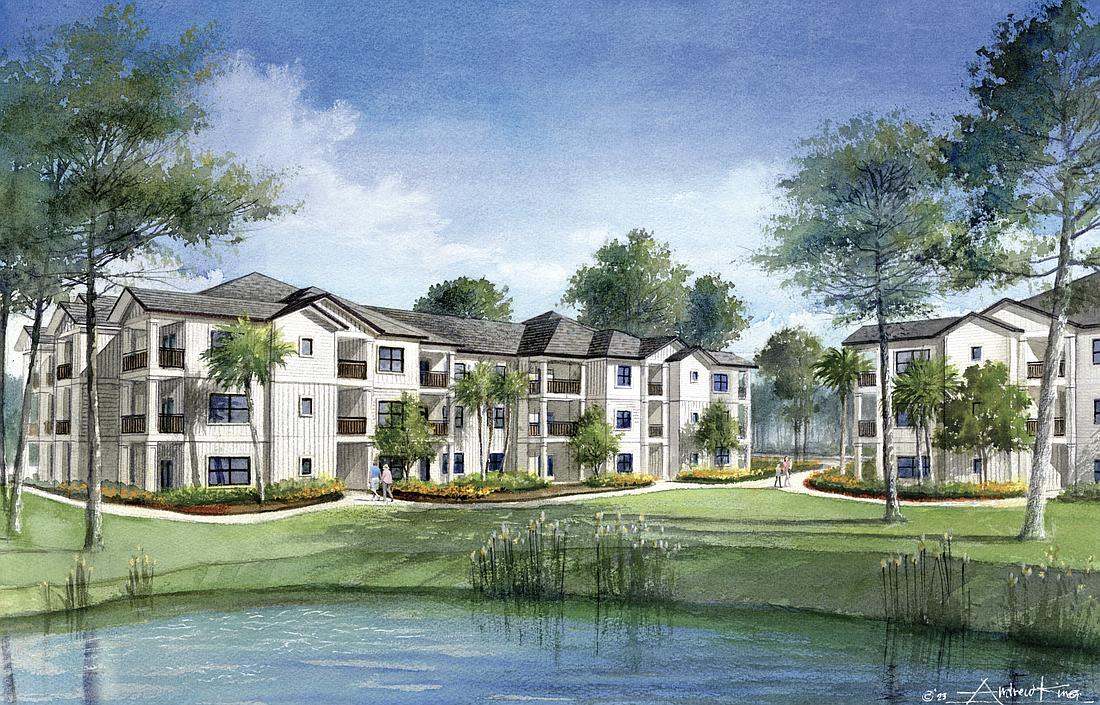- July 26, 2024
-
-
Loading

Loading

Opting for the “lesser evil,” the Ormond Beach City Commission unanimously approved a rezoning and development order for the proposed Tymber Creek Apartments at its meeting on Tuesday, May 16.
Due to the recently signed Live Local Act, previously known as Florida Senate Bill 102, the commission faced a dilemma concerning density. Commissioners were not fully in favor of the 270-unit apartment complex proposal. But the other alternative on the table made possible by the new law — which would let developers build multifamily or mixed-use residential buildings on land zoned commercial, industrial or mixed-use at the highest allowed density without going through the commission’s review process for approval, as long as at least 40% of units are dedicated for affordable housing — created too much uncertainty for the surrounding neighborhoods.
City Planning Director Steven Spraker said the developer, VCP Ormond Beach II, LLC, could likely build up to 525 units on the 19-acre property once the law goes into effect on July 1.
Residents of both the Indian Springs and Moss Point neighborhoods were in favor of the apartments over the alternative, and the commission reluctantly approved the project, weeks after tabling it at an April 18 meeting.
“I appreciate the quality of the project presented with the upgrades to the property, but I do want to go on the record that I too am not happy with the density on this corner, as we discussed ad nauseam,” City Commissioner Lori Tolland said. “The Live Local Act definitely changes the outlook on all our future projects, at least for the next 13 years, and I do understand that it’s an effort to address a deficiency in workforce and affordable housing in the state of Florida, but it has taken away our overall advantage — and that is what we need to make those decisions that are best for our community.”
The approved proposal for the property, located at 36 N. Tymber Creek Road, doesn’t include affordable or workforce housing.
Representatives of both impacted neighborhoods had discussed the project with the developer in the past and were able to negotiate a reduction of units from 300 to 270 as well as increased setbacks and buffers.
Present at the commission meeting to speak on the Live Local Act was lobbyist Jeff Sharkey, CEO and president of Capitol Alliance Group, Inc. Sharkey said the law was an “experiment” aimed at addressing the need for affordable housing, and that Ormond is likely among the first municipal governments impacted by the law.
“This was a big piece of legislation — very bold,” Sharkey said. “[Legislators] knew that there were going to be some issues that people were going to push back on. It may not work in Community X, but it will in Community Y.”
One development aspect not bypassed by the Live Local Act is the requirement to meet concurrency standards.
Commissioner Travis Sargent said he remained troubled by the density of the proposed apartments. He voted yes for the rezoning for the project, but no for the development order.
“Our hospitals are overloaded, our roads, schools, and here we are making a decision on an experiment,” he said.
Commissioner Susan Persis said she would vote no at the April 18 commission meeting due to density, traffic and safety concerns, but said she changed her vote on May 16 after speaking with the residents of Indian Springs and Moss Point.
“I think we’ve all probably had a couple of sleepless nights ... so we just trust you, the developer, to treat Ormond Beach special, and that’s what we would really hope, and think about our residents,” Persis said.
No sidewalks on the east side of A1A from Granada Boulevard to Standish Drive?
The Florida Department of Transportation, as it finalizes plans for its proposed improvements for a 3.61-mile stretch of A1A from East Granada Boulevard to Sandra Drive, asked the City Commission to weigh in on some proposed changes.
FDOT conducted a community meeting on March 22 to discuss the project. Residents overwhelmingly opposed a proposed 6-foot sidewalk and three crosswalks beginning north of East Granada Boulevard to Standish Drive. The residents stated that the sidewalk on the east side could impact driveways, and that the crosswalks were not needed because there is no beach access until Neptune Avenue.
The commissioners split 3-2 on whether they favored the sidewalk or not. Commissioners Harold Briley and Susan Persis were in the minority, citing pedestrian safety concerns as the reason to have the sidewalks.
The remainder of the commission felt the proposed 10-foot sidewalk on the west side was sufficient.
The Ormond Beach City Commission unanimously approved an amendment to its code of ordinances to eliminate two positions on the Leisure Services Advisory Board, reducing the board’s membership from 13 to 11.
The commission made the change because the board was having issues meeting quorum. Previously, the commission was interested in reducing the board to seven members, including two alternates.
The advisory board counterproposed eliminating the positions representing the girls’ softball and the Ormond Beach Friends of Recreation, Inc.
The Ormond Beach City Commission unanimously approved the 286-unit RidgeHaven single-family development proposal at its meeting on Tuesday, May 16.
The development is slated to be built on a 103.45-acre property located south of Plantation Oaks Boulevard, east of Addison Drive and north of the Village of Pine Run subdivision. Of the 286 units, 84 are proposed to be duplex townhomes. The rest will be single-family units.
The commission commented on the developer’s plan to add over 1,500 native trees to the subdivision, in addition to keeping 25% of the property in its natural state.
“I really like that the neighboring residents are at least 250 feet away from this development,” Commissioner Susan Persis said.